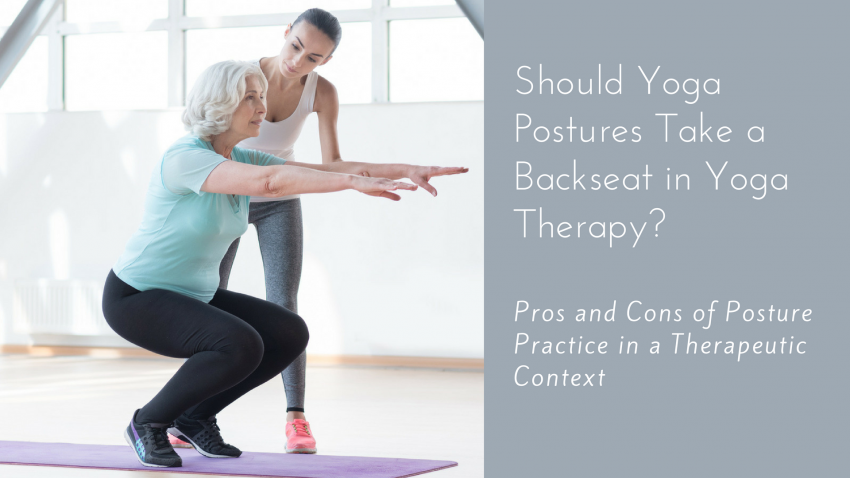View basket (0 items $0.00)

Should Yoga Postures Take a Backseat in Yoga Therapy? A New Research Paper Tackles a Bold, But Controversial Question
Are current yoga therapy strategies, practices and programs living up to their intended purpose? A recent critique of yoga therapy in the Journal of Primary Care & Community Health tackles this thorny, but important question.
Although well-intentioned, the article’s fundamentally inaccurate portrayal of yoga therapy sets it on a misguided course that left many of its conclusions moot. In particular, the call for yoga therapists to eliminate the use of yoga postures demonstrates a lack of understanding of the intention, function and therapeutic value of asana.
The Difference between Yoga and Yoga Therapy
As one of the Eight Limbs of Yoga, physical postures are designed to facilitate the health and wellbeing of mind, body and spirit. When comparing the practice of yoga to yoga therapy however, the intended purpose of these postures and how they are used are often fundamentally different.
Although there are myriad reasons why students pursue yoga, mainstream classes are typically exercise-oriented, and structured to meet the general needs of a reasonably able-bodied group of individuals. The overarching role of teachers then, is to provide instruction that empowers students to move safely and with biomechanical intelligence.
Unlike traditional yoga students, clients often seek yoga therapy to manage a health condition, or to obtain relief from physical or psychological discomfort. The yoga therapy process is personalized, goal-directed, and involves the systematic assessment of mind and body functioning including lifestyle behaviors that may enhance or impede a practitioner’s healing.
Therapeutic recommendations can, and often do, include everything from breath and relaxation exercises, guided imagery, mantra, and chanting, to expertly selected and sequenced movements that specifically address the client’s goals. Although client motivations are often symptom- or disease-specific, therapy encompasses a holistic view of functioning rather than solely treating the disease itself.
This attention to the needs of the person requires yoga therapists to have extensive training in human anatomy, physiology, biomechanics, psychology and disease pathology, as well as having a high degree of clinical skill including listening, interviewing, observing, and developing a strategic therapeutic plan that wisely makes use of the yogic technologies available.
Yoga Therapy Is Not Movement-centric
In the article, the author, who has authored several critiques of the shortcomings of yoga research policy and practice, takes aim at yoga therapy by describing it as a “practice of performing numerous intricate postures, continuously challenging the gymnastic prowess, and culminating in an aesthetically pleasing and spiritually uplifting experience…” He goes on to propose a “new model of yoga…wherein postures take a back seat or even disappear from the gamut.”
This fundamental misrepresentation of yoga therapy not only undermines the author’s point that greater attention needs be paid to the safety and function of yoga postures, but also paints a grossly inaccurate and harmful caricature of the field.
First, the majority of individuals that I, and my yoga therapist colleagues serve, range from children to those of very advanced age, male and female. The majority of my clients are largely unwilling and unable to perform advanced postures, and have little or no desire to develop their gymnastic skills. They seek relief from a breadth of physical and mental health challenges, and are as interested in the philosophical and psychological nuances of yoga as they are movement. Most, if not all find symptom relief and empowerment in executing intelligently designed movement sequences that specifically address their needs and goals, in combination with other ancient yoga technologies.
Bias in Yoga Research
The field of yoga research, like many others in which scientists are attempting to create an evidence base to support the use of a non-allopathic form of care, is plagued by a number of issues. While some concerns are justifiable, and have been amply articulated elsewhere, the field at large is embarked in continuous self-inquiry that includes an openness to examining its flaws.
For example, we recognize that both yoga and mindfulness research may suffer from a “file drawer problem” wherein negative findings are not reported, and the benefits and risks of the practices are not given equal weight in the published literature.
I wholeheartedly disagree with the author that “the fundamental principles or tenets of yoga seem to be off limits for debate.” While serving as Editor in Chief for the International Journal of Yoga Therapy, I participated in numerous animated exchanges with yoga therapists, teachers and researchers from around the world regarding whether or not scholars should engage in “a reductionist approach to the study of yoga” as the author of the critique recommends, or adopt a holistic, ecological framework that honors yoga’s complex interplay of philosophies and practices, rather than its constituent parts.
Those in the yoga research community are astutely aware that yoga research, like that of most other health disciplines, can never capture the immensely multifaceted context that defines human life, development, and disease. To suggest that yoga research, as a field, ignores these realities is to again, paint a biased and inaccurate portrait of the work being done.
The Case for Regulation in Yoga
The author addresses the need for regulation in yoga to “protect clients from the risks of injuries ensuing from yoga practice or therapy as a result of inadequate training and expertise of yoga therapists or teachers”. He goes on to cite an article which noted that “headstand, shoulder stand, lotus position, and forceful breathing were the most common causes for injuries”, and that these poses were not essential to the practice of yoga therapy.
I wholeheartedly agree. I know of few, if any, qualified and/or certified yoga therapists who would include these postures in a therapeutic sequence without significant justification, or who would argue for the therapeutic benefit of any posture that places vertical or lateral pressure on the neck given the emerging research regarding the dangerous biomechanical force placed on the cervical spine.
The best way to ensure that yoga therapy is practiced safely is to educate the public, health care providers, and insurers regarding minimally acceptable education and experience for yoga therapists. While I concur that this does not require regulation, I do believe that we bear a personal responsibility to make certain that these criteria are met before working with clients.
This article raises an important topic – namely, the ongoing need to for yoga education that emphasizes the safety and accessibility of yoga postures, particularly for less able-bodied students. Simply dismissing the use of postures in yoga therapy, or pointing the finger at the research community does nothing to facilitate that end or to advance the field.
The author concludes his critique by noting that although yoga has established benefits, its utility is dampened by a lack of reflection by stakeholders on the big picture issues named above. While I agree that the field of yoga, in accordance with its own philosophies, requires our continuous reflection, this self-study is little served by biased commentaries that misrepresent the practice of yoga therapy .
Sources
Patwardhan AR (2017). Aligning yoga with its evolving role in health care: Comments on yoga practice, policy and research. Journal of Primary Care & Community Health, 8(3), 176-179.
 B Grace Bullock, PhD, E-RYT 500 is a psychologist, research scientist, educator, yoga and mindfulness expert and author of Mindful Relationships: Seven Skills for Success - Integrating the Science of Mind, Body and Brain. Her mission is to reduce stress, increase health and well-being and improve the quality of relationships. She offers classes, workshops, writing and research that combine the wisdom of applied neuroscience, psychophysiology, psychology and contemplative science and practice. Her goal is to empower individuals, groups, leaders and organizations to reduce chronic stress and increase awareness, attention, compassion, mindfulness and effective communication to strengthen relationships, release dysfunctional patterns and unlock new and healthy ways of being. Dr. Bullock is also the Founding Director and Principal Consultant of the International Science & Education Alliance, an organization devoted to exceptional research, program evaluation, assessment design, strategic planning and capacity building to support equity, programmatic diversity and scientific integrity, and promote effective leadership, decision-making and social change. Bullock is a Certified Viniyoga Therapist and Faculty at the Integrated Health Yoga Therapy (IHYT) Training program. She is the former Senior Research Scientist at the Mind & Life Institute and former Editor-in-Chief of the International Journal of Yoga Therapy. For more information see www.bgracebullock.com.
B Grace Bullock, PhD, E-RYT 500 is a psychologist, research scientist, educator, yoga and mindfulness expert and author of Mindful Relationships: Seven Skills for Success - Integrating the Science of Mind, Body and Brain. Her mission is to reduce stress, increase health and well-being and improve the quality of relationships. She offers classes, workshops, writing and research that combine the wisdom of applied neuroscience, psychophysiology, psychology and contemplative science and practice. Her goal is to empower individuals, groups, leaders and organizations to reduce chronic stress and increase awareness, attention, compassion, mindfulness and effective communication to strengthen relationships, release dysfunctional patterns and unlock new and healthy ways of being. Dr. Bullock is also the Founding Director and Principal Consultant of the International Science & Education Alliance, an organization devoted to exceptional research, program evaluation, assessment design, strategic planning and capacity building to support equity, programmatic diversity and scientific integrity, and promote effective leadership, decision-making and social change. Bullock is a Certified Viniyoga Therapist and Faculty at the Integrated Health Yoga Therapy (IHYT) Training program. She is the former Senior Research Scientist at the Mind & Life Institute and former Editor-in-Chief of the International Journal of Yoga Therapy. For more information see www.bgracebullock.com.
Featured Courses








